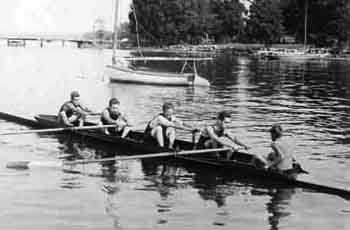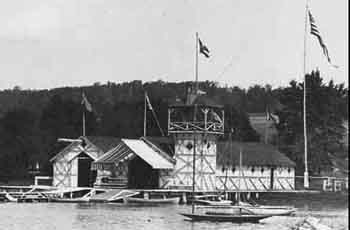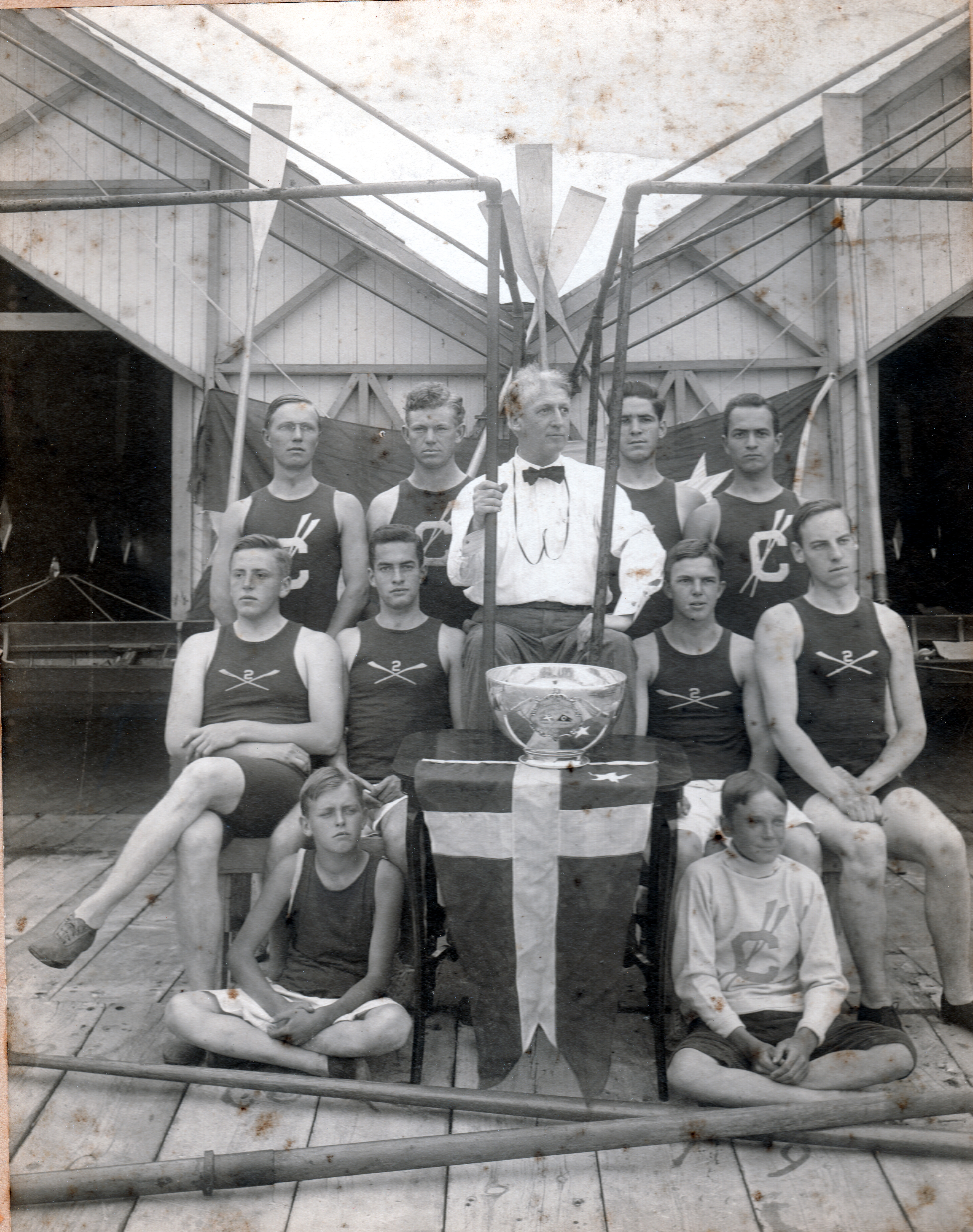History of Rowing on Chautauqua Lake

Photos of Chadakoin Rowing Club1890's-1930's - originals at Fenton Historical Society

The Following history has been taken from that which was compiled by Harold Griffith and Robin Johnson in 1981 for the Chautauqua Lake Yacht Club's publication "the Breeze":
The Chadakoin Club, Chautauqua Lake's first rowing club, was initially located in Greenhurst, NY, situated between the Greenhurst Inn (no longer in existence) and Sheldon Hall (still standing today), both prominent resorts at the time. To chart the history of the Chadakoin Club is a nearly impossible task, primarily because important historical documents were destroyed in a fire to the second Chadakoin boathouse on November 11, 1928. Because of this, the early history of the Chadakoin Club, and consequently the early history of the Chautauqua Lake Yacht Club, is based almost entirely on the ability of interested parties to recall facts and dates.
The Chadakoin Club (now existing as the Chautauqua Lake Yacht Club) was founded by a group of amateur rowers (calling themselves the Corinthians) in 1894. The enthusiasts purchased two four oar shells and a four oar work boat; the shells were used for racing, and the work boats, only for practicing. Excited about competing, the Chadakoin oarsman accepted a challenge from the members of the Chautauqua Sports Club, now the Chautauqua Yacht Club, located at Chautauqua, NY, at the upper end of the lake. The Chautauqua oarsmen were mostly college students spending their summers at the Chautauqua Institution, and eager for any competition that would keep them in shape for training when they returned to school.
The event was scheduled for sometime during the month of August 1895, and for weeks prior to the competition the Chadakoin's first and second crews practiced in front of their club, devising what proved to be their secret weapon: a quick start and a steady stroke. A later article that appeared in the Jamestown Evening Journal reports: "The machine-like precision of the Chadakoin crew was noticeable. The Chautauqua crew had a more rapid stroke but not so effective." You can imagine the surprise to the confident Chautauqua oarsmen when the Chadakoin crew covered the one mile course in 6.18 3/4 minutes. (One mile courses were rowed in 1895, 1896, and 1897; from then until the last race in 1917 the first crew rowed 1.5 miles and the second crew rowed one mile. Races were rowed alternately at both clubs.)
It was, indeed, a popular event, and the late afternoon race -- held at a time when the water would be smooth -- attracted throngs of spectators who viewed the races on land and from large steamers. "A great multitude sat about on the hills of the Holy Land of Chautauqua to watch," according to an account from the Jamestown Evening Journal after the first race. Theodore E. Miller of the Chautauqua Club donated a silver bowl with the nameled burgees of each club and the inscription "Dedicated to the Annual Chadakoin-Chautauqua Rowing Race." The trophy, engraved with crews and times, is now in the possession of the Chautauqua Lake Yacht Club, and can be seen in its clubhouse, along with other historical memorabilia, including photographs of the shells.
It wasn't merely luck that accounted for the Chadakoin's success; of the twenty annual contests the Chadakoin club won thirteen and the Chautauqua Sports Club won seven. In fact, it was so common for the older Chadakoin oarsmen to win that headlines in the newspapers at the time read "Chadakoin Wins Another Victory," and "Nothing To It, But Chadakoin." William Broadhead, CLYC Past Commodore and father of Almet Broadhead, who at one time coached the oarsmen, emphasized the discipline and dedication necessary for a successful rowing club. Broadhead, in an interview given in 1962, commented that most of his crew were young working men who practiced evenings after a full day on the job. After practice they ate a training table supper at Sheldon Hall, and later at the Lakewood Inn, after the club relocated in Lakewood.
Smoking, drinking, and carousing were forbidden! To demonstrate how serious the men were, one needs only to listen to the stories of the long endurance practices on Sunday mornings, about how the crews waxed their boats prior to the competitions, and about how sightings of the race courses were taken once the lake was frozen. But there was fun, too! One of the oarsmen, John Osmer, used to perch his fiance, facing him, on the deck of the working boat, and every time he came forward on a reach he would give her a kiss.
Several reasons have been offered as to why crew racing was abandoned at the Chadakoin Club after 1917: greater mobility resulted because of the invention of the automobile, golf developed into a popular new sport, and young crews were unwilling to spend the necessary hours practicing. It wasn't until 1939 that Chadakoin crewmen once again rowed competitively. With only one shell left at the club, the Chadakoin oarsmen rowed against the West Side Rowing Club of Buffalo. The experienced Buffalo crew demoralized the Chautauqua oarsmen, and that ended rowing not only at the club, but on Chautauqua Lake.

